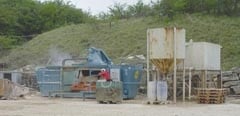Stone Sources: Glebe Stone Sales Ltd's Ancaster Hard White
A new Wells Wellcut, as well as a cropper and a tumbler from the same British machinery manufacturer, have been installed in Glebe Quarry, Lincolnshire, ready to meet the demand for walling in Ancaster limestone now that the housing market is starting to take off again. NSS visited Terry Smith and his son Andrew, who run the quarry, to hear about the latest moves.
Ancaster Hard White, Weatherbed and Freestone can be seen on some of the most prestigious heritage buildings of the East Midlands – buildings such as Wollaton Hall, St Botolph's Church in Boston (affectionately known as ‘The Stump’) and Stoke Rochford Hall, to name just a few. And it is still being used for some of the most prestigious building projects around the country.
But now it is also available from Glebe Stone Sale’s Ancaster quarry as walling stone for more modest homes in anticipation of an increase in activity to meet the on-going housing shortage.
Glebe Quarry is owned by Lincoln Diocese and leased by Terry Smith and his son Andrew, who operate the quarry on their own these days, having bought out their partners in 2010.
The lease includes planning permission to extend the quarry into a 15hectare (37acre) area of the fields beyond its present boundary, which should ensure continuing supplies of one of the region’s best known stones for many years to come at its current rate of extraction – sales were 2,860 tonnes last year, 60% of it Hard White.
Since 2010, Glebe has been investing in the stone extraction to improve efficiency. “We need to get people out of the idea that stone is expensive,” says Terry. “Stone processing has become cheaper while other building materials have become more expensive – not to mention how sustainable stone is with low carbon emissions in processing and, when it’s from the UK, transport.”
Glebe has previously only extracted block that has been sold to customers such as Nick Bristow’s Glebe Stone company and Gary Dickman’s Ancaster Stone company – companies that saw the stone and sell it as masonry.
But now, Terry and Andrew have also moved into processing with the purchase of a saw, cropper and tumbler from Lincolnshire neighbours Wells Wellcut with the aim of supplying walling stone, especially in the Ancaster Hard White.
The Hard White is the most popular of the Ancaster stones, so it is unfortunate that the beds of it occur under the harder weatherbed, although Glebe hopes that by slabbing the blocks itself (while continuing to sell block to other processors) it will also be able to increase interest in the weatherbed by separating out the buff, blue and mixed stone and selling them separately to offer distinct colour ranges.
Below the Hard White is a freestone, which contains more shell than the particularly clean Hard White. The bedding plane between the Weatherbed and the Hard White is evident, but there is no such clear distinction between the Hard White and the Freestone and it is up to customers, advised by the quarry, to determine what constitutes too much shell for a particular project.
By sawing, cropping and tumbling its own stone for walling, Glebe is reducing waste by using more of the stone it extracts, which would otherwise be discarded.
When masonry companies buy stone they want large, regular-shaped blocks for ease of processing. That leaves a lot of perfectly good stone unsold. But now it can be transformed into a much-needed product.
It was not so many years ago that the stone was extracted at Glebe using hand-held drills. But vibration limits mean drills can only be used for 11minutes at a time by each operator on the Weatherbed and 13 minutes on the Hard White.
Most of the drilling is now carried out using a Turkish-made rock drill powered by a Doosan compressor, and blocks are sawn from the bed using a Fantini with a 2.1m long blade – it is a limited length so the benches are always less than 2m high, which means fewer health & safety issues than if they go above 2m.
Hand-held drills are still used at the quarry and the operators are examined every year by a doctor to make sure they are showing no signs of vibration injury. “I have no problem with that,” says Terry. “White finger isn’t nice.”
One of the reasons Ancaster, especially the Hard White, is in high demand is because it has proved so durable over many centuries. In the nature of procurement these days Glebe does offer a full set of test results, but Terry believes a far better measure of the quality of the stone is to look at how well it has weathered in buildings that are hundreds of years old.
There are a lot of buildings constructed using Ancaster Hard White all over the East Midlands and further afield, even into London, notably (but not exclusively) on the hotel in front of St Pancras railway station.
Ancaster was sometimes used instead of Portland limestone because it was less expensive than Portland – an attribute it still claims.
Another reason it was so widely used as far back as Saxon times was that it was close to tidal water in the Fenns, before the Fenns were drained. Even after they had been drained, a stream led to the Witham and from there into the River Trent, providing access to a much wider area.
Once the railways were built, horses would pull blocks of the stone on sledges from the quarry to the rail terminal, from where they could go all over the country.

